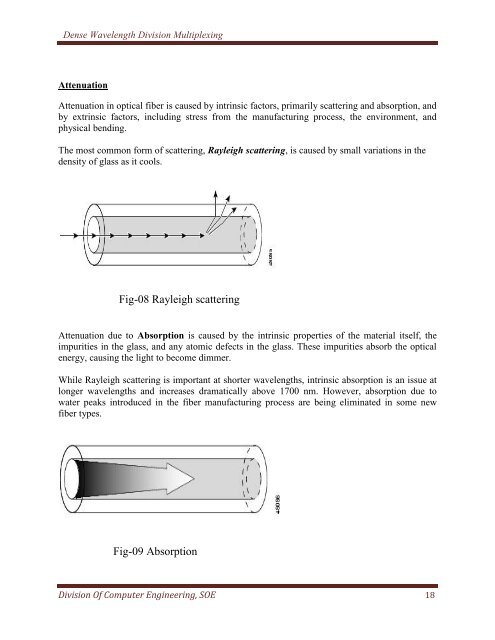Dense Wavelength Division Multiplexing - DSpace at CUSAT ...
Dense Wavelength Division Multiplexing - DSpace at CUSAT ...
Dense Wavelength Division Multiplexing - DSpace at CUSAT ...
You also want an ePaper? Increase the reach of your titles
YUMPU automatically turns print PDFs into web optimized ePapers that Google loves.
<strong>Dense</strong> <strong>Wavelength</strong> <strong>Division</strong> <strong>Multiplexing</strong><br />
Attenu<strong>at</strong>ion<br />
Attenu<strong>at</strong>ion in optical fiber is caused by intrinsic factors, primarily sc<strong>at</strong>tering and absorption, and<br />
by extrinsic factors, including stress from the manufacturing process, the environment, and<br />
physical bending.<br />
The most common form of sc<strong>at</strong>tering, Rayleigh sc<strong>at</strong>tering, is caused by small vari<strong>at</strong>ions in the<br />
density of glass as it cools.<br />
Fig-08 Rayleigh sc<strong>at</strong>tering<br />
Attenu<strong>at</strong>ion due to Absorption is caused by the intrinsic properties of the m<strong>at</strong>erial itself, the<br />
impurities in the glass, and any <strong>at</strong>omic defects in the glass. These impurities absorb the optical<br />
energy, causing the light to become dimmer.<br />
While Rayleigh sc<strong>at</strong>tering is important <strong>at</strong> shorter wavelengths, intrinsic absorption is an issue <strong>at</strong><br />
longer wavelengths and increases dram<strong>at</strong>ically above 1700 nm. However, absorption due to<br />
w<strong>at</strong>er peaks introduced in the fiber manufacturing process are being elimin<strong>at</strong>ed in some new<br />
fiber types.<br />
Fig-09 Absorption<br />
<strong>Division</strong> Of Computer Engineering, SOE 18

















